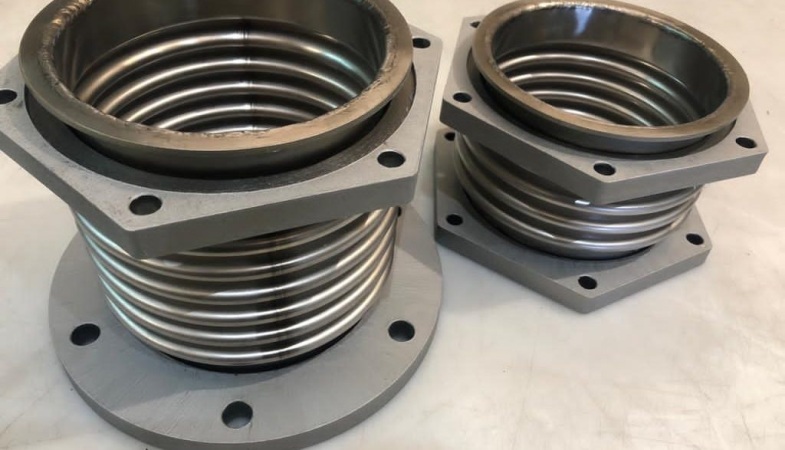
The metal expansion joints market has witnessed substantial growth over the years, driven by various factors such as increasing industrialization, infrastructure development, and the need to mitigate the adverse effects of thermal expansion in pipelines and ducting systems. The metal expansion joints market is poised to grow at a CAGR of 5% during the forecast period of 2025 to 2033, driven by factors such as increasing industrialization, stringent regulatory standards, and technological advancements. However, the market faces challenges associated with fluctuating raw material prices. The demand for various expansion joint types, including tied single expansion joints, is expected to rise significantly during the forecast period. Geographically, Asia-Pacific is anticipated to witness the highest growth rate, fuelled by industrial expansion in emerging economies. To thrive in this competitive landscape, companies are focusing on innovation and strategic collaborations. Overall, the metal expansion joints market is on a growth trajectory, offering lucrative opportunities for industry participants.

Growing Industrialization and Infrastructure Development
The rapid pace of industrialization and infrastructure development worldwide has significantly contributed to the expansion joints market's growth. Industries such as oil and gas, petrochemicals, power generation, and HVAC systems are increasingly relying on metal expansion joints to address thermal stresses and vibrations. With emerging economies investing in infrastructure projects and the expansion of industrial facilities, the demand for metal expansion joints is expected to surge. For instance, the Belt and Road Initiative in China, aimed at enhancing connectivity and trade, involves extensive infrastructure development, driving the need for expansion joint systems. Additionally, the shale gas boom in North America has led to increased pipeline construction, further boosting the demand for metal expansion joints in the energy sector.
Stringent Regulatory Standards and Environmental Concerns
Environmental regulations and safety standards have become more stringent across industries. Metal expansion joints play a crucial role in ensuring the integrity of pipelines and ducting systems, preventing leaks, and reducing the risk of environmental hazards. For instance, in the chemical and petrochemical industry, the handling of hazardous chemicals necessitates the use of expansion joints to maintain system reliability and safety. The enforcement of these regulations, along with the increasing awareness of environmental concerns, has propelled the adoption of metal expansion joints. Moreover, as industries strive to achieve energy efficiency and reduce emissions, expansion joints are deployed to minimize energy loss, contributing to their widespread use.
Technological Advancements in Expansion Joint Design
Technological advancements have led to the development of more efficient and durable expansion joints. Innovations in materials, such as the use of high-performance alloys and advanced elastomers, enhance the expansion joints' longevity and performance. Additionally, manufacturers are designing expansion joints with predictive maintenance capabilities, enabling early detection of potential issues and reducing downtime. These technological enhancements not only improve the reliability of industrial processes but also drive the replacement and retrofitting of existing expansion joint systems. The constant pursuit of innovative solutions by manufacturers is expected to bolster the metal expansion joints market during the forecast period.
Fluctuating Raw Material Prices
One of the significant restraints in the metal expansion joints market is the volatility in raw material prices, particularly metals, and alloys like stainless steel and Inconel. The prices of these materials are susceptible to various factors, including supply-demand dynamics, geopolitical tensions, and economic conditions. Such fluctuations can impact the production costs of expansion joints, affecting manufacturers' profit margins and product pricing. Furthermore, the uncertainty in raw material prices can make long-term planning and cost estimation challenging for both manufacturers and end-users. To mitigate this restraint, industry participants often engage in strategic partnerships and long-term contracts with suppliers to secure a stable supply of raw materials.
Product Type (Axial Expansion Joints, Universal Expansion Joints, Tied Single Expansion Joints, Tied Double Expansion Joints, Others): Axial Expansion Joints Dominate the Market
In 2024, the Axial Expansion Joints segment accounted for the highest revenue within the metal expansion joints market. However, during the forecast period from 2025 to 2033, the Tied Single Expansion Joints segment is expected to demonstrate both the highest revenue and the highest compound annual growth rate (CAGR). This growth can be attributed to the increased demand for tied single expansion joints in applications where a balance between axial and lateral movements is required, such as in power generation and chemical processing plants.
Distribution Channel (Direct, Indirect): Direct Distribution Channel Dominates the Market
In 2024, the direct distribution channel dominated the metal expansion joints market due to manufacturers' direct sales to end-users. However, during the forecast period from 2025 to 2033, the indirect distribution channel is expected to exhibit the highest CAGR. This growth is attributed to the expansion of distribution networks, including distributors and suppliers, to reach a broader customer base. Indirect channels offer convenience to end-users by providing a one-stop solution for various expansion joint types and sizes.
North America Remains as the Global Leader
Geographically, North America held the highest revenue percentage in the metal expansion joints market in 2024, driven by extensive industrialization and the presence of major manufacturing industries. However, Asia-Pacific is expected to demonstrate the highest CAGR during the forecast period. This growth is fueled by the region's expanding industrial base, particularly in emerging economies like China and India. As these countries continue to invest in infrastructure development and industrial expansion, the demand for metal expansion joints is set to soar. Additionally, the Middle East and Africa region is witnessing increased investment in oil and gas projects, further boosting the market.
Market Competition to Intensify during the Forecast Period
The metal expansion joints market is characterized by intense competition, with several key players striving to maintain their market positions. Notable companies operating in this market include Senior Flexonics, Witzenmann, Texpack, Unisource Manufacturing Inc., Eagleburgmann, Garlock, Bikar-Metalle Gmbh, Metraflex, Aerosun-Tola, Nicoform, Macoga, Gongyi Runda Pipeline, And Triad Bellows. These companies focus on strategic initiatives such as mergers and acquisitions, product innovations, and partnerships to strengthen their market presence. Additionally, there is a growing emphasis on developing expansion joints with advanced materials and improved performance capabilities to meet the evolving needs of end-users.
Historical & Forecast Period
This study report represents analysis of each segment from 2023 to 2033 considering 2024 as the base year. Compounded Annual Growth Rate (CAGR) for each of the respective segments estimated for the forecast period of 2025 to 2033.
The current report comprises of quantitative market estimations for each micro market for every geographical region and qualitative market analysis such as micro and macro environment analysis, market trends, competitive intelligence, segment analysis, porters five force model, top winning strategies, top investment markets, emerging trends and technological analysis, case studies, strategic conclusions and recommendations and other key market insights.
Research Methodology
The complete research study was conducted in three phases, namely: secondary research, primary research, and expert panel review. key data point that enables the estimation of Metal Expansion Joints market are as follows:
Market forecast was performed through proprietary software that analyzes various qualitative and quantitative factors. Growth rate and CAGR were estimated through intensive secondary and primary research. Data triangulation across various data points provides accuracy across various analyzed market segments in the report. Application of both top down and bottom-up approach for validation of market estimation assures logical, methodical and mathematical consistency of the quantitative data.
| ATTRIBUTE | DETAILS |
|---|---|
| Research Period | 2023-2033 |
| Base Year | 2024 |
| Forecast Period | 2025-2033 |
| Historical Year | 2023 |
| Unit | USD Million |
| Segmentation | |
Product
| |
Application
| |
Distribution Channel
| |
|
Region Segment (2023-2033; US$ Million)
|
Key questions answered in this report